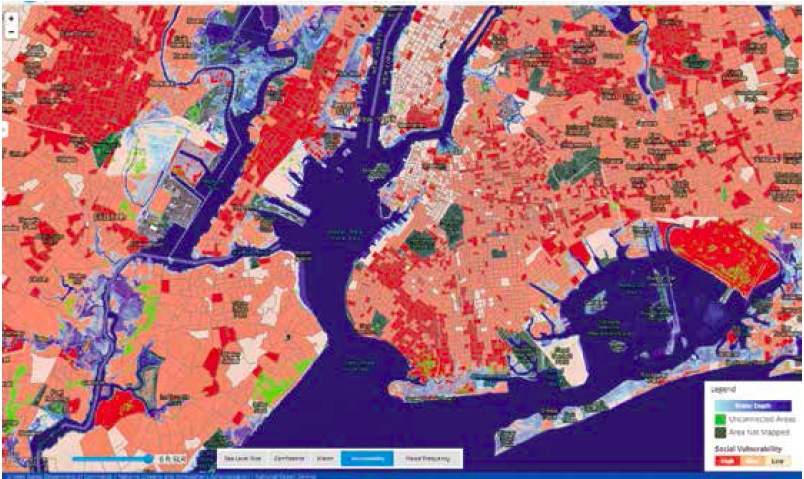URBAN LAND INSTITUTE
Introduction
Hurricane Sandy was the worst natural disaster ever to hit the New York−New Jersey region. When it landed on October 29, 2012, the region was unprepared for its impact despite years of reports and warnings that an event like Sandy was a probability in the near future. Climate experts are now saying that although many aspects of Sandy were unique, the region will likely experience events of its magnitude with increasing frequency in the decades ahead.
Adding to the ferocity of the storms expected in the future is the seemingly inexorable rise in sea levels, a major challenge for coastal regions around the world. The most recent projections estimate that sea levels will rise in New York City in the range of 20 to 36 inches by 2100.1 The National Oceanic and Atmospheric Administration’s map of sea level rise shows clearly that many of the most vulnerable areas in New York and New Jersey were fortunate to have avoided the worst consequences of Sandy, while some seemingly safe areas were caught in Sandy’s relatively unusual trajectory. This outcome points to the extraordinary unpredictability of major weather events and underscores the fact that long-term planning must be based on assessing the risk or potential for harm in the future, not on the degree of damage caused by past events.
In short, climate change is here to stay, though how severe it may become depends on our ability as humans to mitigate its causes and to create resilient communities that can absorb its impact and continue to thrive and grow. Most urban regions around the world are especially vulnerable to these changes. That vulnerability makes the need for evaluating and implementing longer-term strategies for resilience and preparedness in those regions critical today. This need is all the more true given their growing economic, social, and environmental value as the world becomes more urbanized.
BACKGROUND
The New York−New Jersey region has an unusually complex mix of land use patterns that must be taken into account when considering long-term resilience for the region. No one solution can possibly be appropriate for high-density land that is also very high in value (such as Lower Manhattan) and low-density areas with moderate land values (such as Long Beach or the smaller communities along the Staten Island and New Jersey shorelines). In between these extremes is a wide mix of more urban and less urban coastal communities.
Tying this region together is a complex system of infrastructure. Although the region’s infrastructure is aging, it still makes up one of the most extensive, dense, and heavily invested systems in the United States. It is a critical component to the region’s role as one of the most significant economic centers in the nation. As an international center of finance and commerce, what happens in the greater New York− New Jersey region is key to the strategic economic advantage of the country.
Among the many challenges this situation presents is the need to prepare the region’s complex physical, economic, and government systems for this new reality. To that end, the Urban Land Institute (ULI) planned and held a disaster assistance Advisory Services panel (see feature box) to consider how best to develop the long-term resilience and preparedness needed by the region if it is to continue to prosper in this new future successfully. Over its long history, ULI has convened many such panels, bringing a unique perspective to bear on what is needed to best plan for rebuilding after catastrophic events.
The New York−New Jersey region mobilized quickly, and within the year a host of plans has been developed to rebuild the region. Indeed, many plans existed before Hurricane Sandy that were intended to guide the region in preparing for events like Sandy, the second costliest hurricane in U.S. history. These reports, issued both before and after Sandy hit, make up a rich body of recommendations. Although many are quite consistent, some are in conflict, and there also appear to be some gaps in some reports. All of these reports were reviewed by ULI and taken into account by the ULI Advisory Services panel in making its recommendations.
Sea Level Rise and Coastal Flooding Impacts:
Download full version (PDF): After Sandy
About the Urban Land Institute (ULI)
www.uli.org
“ULI, the Urban Land Institute, is a 501(c) (3) nonprofit research and education organization supported by its members. Founded in 1936, we now have members worldwide, representing the entire spectrum of land use and real estate development disciplines working in private enterprise and public service.”
Tags: Climate Change, Hurricane Sandy, New Jersey, New York, NJ, NY, ULI, ULI Advisory Services, Urban land Institute







 RSS Feed
RSS Feed